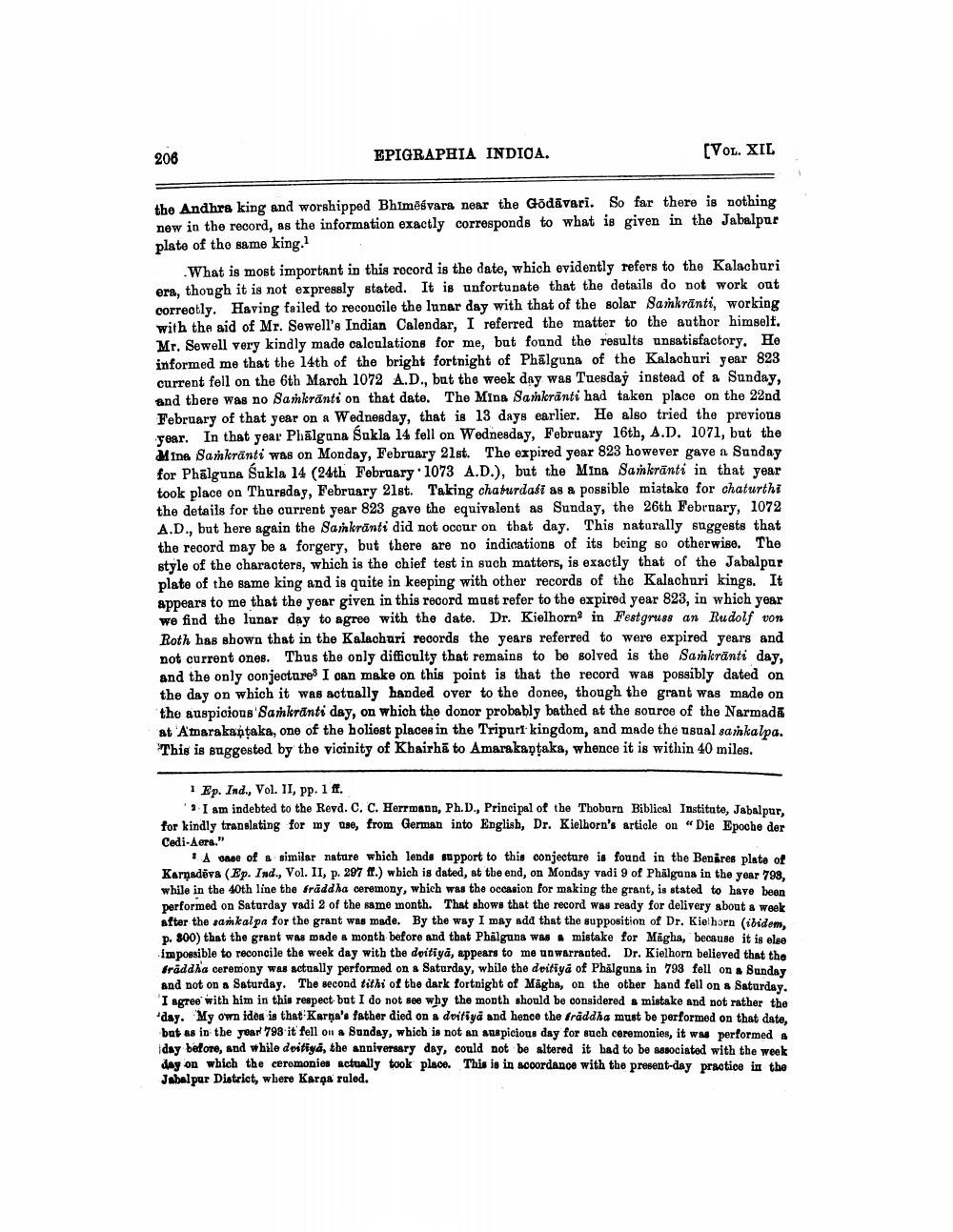________________
206
EPIGRAPHIA INDICA.
(VOL. XIL
the Andhra king and worshipped Bhiměsvars near the Godavari. So far there is nothing new in the record, as the information exactly corresponds to what is given in the Jabalpur plate of the same king.
What is most important in this rocord is the date, which evidently refers to the Kalachuri era, though it is not expressly stated. It is unfortunate that the details do not work out correctly. Having failed to reconcile the lunar day with that of the solar Samkrānti, working with the aid of Mr. Sewell's Indian Calendar, I referred the matter to the author himself. Mr. Sewell very kindly made calculations for me, but found the results unsatisfactory. He informed me that the 14th of the bright fortnight of Phālguna of the Kalachuri year 823 current fell on the 6th March 1072 A.D., but the week day was Tuesday instead of a Sunday, and there was no Sankrānti on that date. The Mina Sankranti had taken place on the 22nd February of that year on a Wednesday, that is 13 days earlier. He also tried the previous year. In that year Phālguna Sukla 14 fell on Wednesday, February 16th, A.D. 1071, but the Mina Samkrānti was on Monday, February 21st. The expired year 823 however gave a Sunday for Phälguna Sukla 14 (24th February 1073 A.D.), but the Mina Samkrānti in that year took place on Thursday, February 21st. Taking chaturdasi as a possible miatako for chaturthi the details for the current year 823 gave the equivalent as Sunday, the 26th February, 1072 A.D., but here again the Sankranti did not occur on that day. This naturally suggests that the record may be a forgery, but there are no indications of its being so otherwise. The style of the characters, which is the chief test in such matters, is exactly that of the Jabalpur plate of the same king and is quite in keeping with other records of the Kalachuri kings. It appears to me that the year given in this record must refer to the expired year 823, in which year we find the lunar day to agree with the date. Dr. Kielhorn in Festgruss an Rudolf von Roth has shown that in the Kalachuri records the years referred to were expired years and not current ones. Thus the only difficulty that remains to be solved is the Sankranti day, and the only conjectures I can make on this point is that the record was possibly dated on the day on which it was actually handed over to the donee, though the grant was made on the auspicious Sankranti day, on which the donor probably bathed at the source of the Narmada at Atarakantaka, one of the holiest places in the Tripurt kingdom, and made the usual sankalpa. This is suggested by the vicinity of Khairhā to Amarakantaka, whence it is within 40 miles.
1 Ep. Ind., Vol. II, pp. 1 ff.
I am indebted to the Revd. C. C. Herrmann, Ph.D., Principal of the Thoburn Biblical Institute, Jabalpur, for kindly translating for my use, from German into English, Dr. Kielhorn's article on "Die Epoche der Cedi-Aera."
we of imilar nature which lends support to this conjecture is found in the Benires plate of Karnadova (Ep. Ind., Vol. II, p. 297 ff.) which is dated, at the end, on Monday vadi 9 of Phålguna in the year 793. while in the 40th line the fräddha ceremony, which was the occasion for making the grant, is stated to have been performed on Saturday vadi 2 of the same month. That shows that the record was ready for delivery about a week after the sankalpa for the grant was made. By the way I may add that the supposition of Dr. Kielhorn (ibidem. p. 800) that the grant was made a month before and that Phalguns was mistake for Migha, because it is else impossible to reconcile the week day with the dpitiya, appears to me unwarranted. Dr. Kielhorn believed that the fraddha ceremony was actually performed on a Saturday, while the deitiya of Phålguns in 793 fell on a Sunday and not on Saturday. The second tithi of the dark fortnight of Mighs, on the other hand fell on a Saturday, 'I agree with him in this respect but I do not see why the month should be considered a mistake and not rather the day. My own idea is that Karga's father died on a doitiya and hence the fraddha must be performed on that date, bat as in the year 793 it fell on a Bunday, which is not an auspicious day for such ceremonies, it was performed a day before, and while doitiga, the anniversary day, could not be altered it bad to be associated with the week day on which the ceremonies actually took place. This is in scoordance with the present-day practice in the Jabalpur District, where Karga roled.




